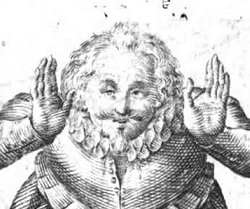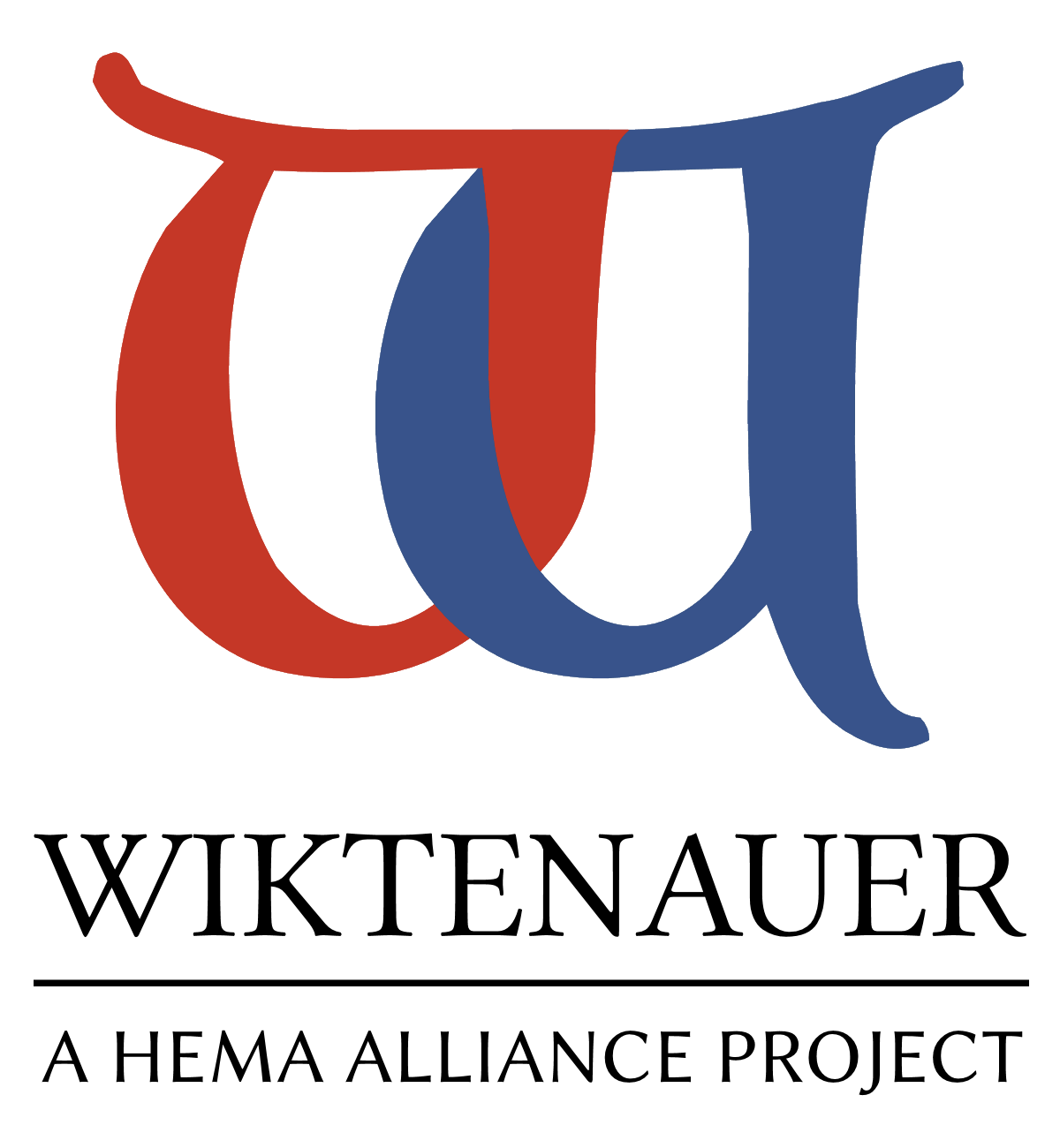|
|
You are not currently logged in. Are you accessing the unsecure (http) portal? Click here to switch to the secure portal. |
Difference between revisions of "Joachim Köppe"
m |
m |
||
| Line 11: | Line 11: | ||
| deathdate = after 1638 (?) | | deathdate = after 1638 (?) | ||
| deathplace = Magdeburg (?), perhaps Brandenburg | | deathplace = Magdeburg (?), perhaps Brandenburg | ||
| − | | occupation = Physician, [[ | + | | occupation = Physician, [[Amateur fencer]]{{#set: occupation=Fencing master }} |
| nationality = German | | nationality = German | ||
| ethnicity = | | ethnicity = | ||
| Line 44: | Line 44: | ||
He and his brother Jacob enrolled at the University of Wittenberg on May 1, 1596. A note in the ''Album Academiae Vitebergensis'' [Ältere Reihe] mentions that “''hi propter aestatum non iuravunt''"—that "because of their [young] age" they did not swear the academic oath. Since the younger brother Jacob (1585-1622), was 11 at that time, Joachim's birth date would be around 1582-83. | He and his brother Jacob enrolled at the University of Wittenberg on May 1, 1596. A note in the ''Album Academiae Vitebergensis'' [Ältere Reihe] mentions that “''hi propter aestatum non iuravunt''"—that "because of their [young] age" they did not swear the academic oath. Since the younger brother Jacob (1585-1622), was 11 at that time, Joachim's birth date would be around 1582-83. | ||
| − | A number of published medical disputations place him at Wittenberg from 1601 to 1609, both as a student of medicine and an examiner. In 1606, he obtained a doctorate in philosophy from the University of Frankfurt an der Oder. Between 1609 and 1610, he was at Paris, where he met [[Salvator Fabris]] and received a copy of Fabris' 1606 book from the master. On April 2, 1610, Magister Köppe appears in the Matrikel of the new University of Giessen, | + | A number of published medical disputations place him at Wittenberg from 1601 to 1609, both as a student of medicine and an examiner. In 1606, he obtained a doctorate in philosophy from the University of Frankfurt an der Oder. Between 1609 and 1610, he was at Paris, where he met [[Salvator Fabris]] and received a copy of Fabris' 1606 book from the master. On April 2, 1610, Magister Köppe appears in the Matrikel of the new University of Giessen, roughly contemporaneously with Heinrich von und zum Velde. |
| − | At Wittenberg, Köppe studied fencing under his ''praeceptor'' Heinrich Beler from Bautzen (a town in in Saxony), as well as at least one other instructor, a German who appears to have been in the tradition of the old ''Fechtergesellschaften''. After he left Wittenberg, he | + | At Wittenberg, Köppe studied fencing under his ''praeceptor'' Heinrich Beler from Bautzen (a town in in Saxony), as well as at least one other instructor, a German who appears to have been in the tradition of the old ''Fechtergesellschaften''. After he left Wittenberg, he became a physician and, later, ''Bürger'' in Magdeburg. In 1619, he published his own treatise on [[rapier]] fencing titled ''[[Newer Discůrs Von der Rittermeszigen und Weitberůmbten Kůnst des Fechtens (Joachim Köppe)|Newer Discůrs Von der Rittermeszigen und Weitberůmbten Kůnst des Fechtens]]'' ("New Discourse on the Knightly and World Renowned Art of Fencing"). This was conceived as the first of at least three volumes, however, only this one volume was ever printed (albeit in four editions). |
| − | His father's funerary sermon | + | His father's funerary sermon identifies him as the ''"verordnete Physicus deß stifftes zu Brandenburg"'' -- as the "assigned physician of the [Dom]stift Brandenburg", about 70km distance from the Magdeburg Old Town. Grain allotments in the Stift's ledgers place ''Medicus'' Köppe at Brandenburg from 1621/22 until 1623/24. His 1625 edition, published in the year of a major plague outbreak, contains a list of errata, which indicates that he was personally involved with it—likely back at Magdeburg. |
| − | A “Köppe, Joachimus” appears from 1631 to 1638 in the ''Bürgerrolle der Alten Stadt Magdeburg''. This would indicate that he survived the complete destruction of the city in 1631 or returned to Magdeburg afterwards. | + | A “Köppe, Joachimus” appears from 1631 to 1638 in the ''Bürgerrolle der Alten Stadt Magdeburg''. This would indicate that he survived the complete destruction of the city in 1631 by Tilly and the ''Kaiserlichen'' or he returned to Magdeburg soon afterwards. No biographical data have been located beyond 1638, as even the 1639 and 1642 editions may have been printed posthumously using the same plates as the 1619 edition. |
| − | Köppe is probably the most erudite and best-educated fencer of his | + | Apart from his fellow Wittenberg and Giessen alumnus zum Velde, Köppe is probably the most erudite and best-educated fencer of his time—as comfortable (and passionate) publishing on arcane theological questions as writing on complex aspects of astronomy. Contrary to modern assertion, he was not and never considered himself a professional instructor or ''Fechtmeister'': Indeed, he expressly rejects the notion that, by publishing his book, he was abandoning his ''Beruff'', i.e., his avocation as a physician. Where fencing is concerned, he was primarily an enthusiastic amateur, stating that he “''von Jugendt auff / von Natur eine sonderliche inclination zu der FechtKunst bey [sich] befunden''” ("from childhood on had found in his nature a special inclination for the art of fencing"). Köppe’s personal method was an amalgam of various instructors he had encountered. He was an analytical, experienced and eclectic fencer who had learned, acquired and understood fundamentals and skills from the methods of several local and international masters to a degree that he could formulate a coherent, systematic theory of his own. –JCA |
Revision as of 16:03, 28 April 2025
| Joachim Köppe | |
|---|---|
 | |
| Born | 1582 or 1583 (?) Bahrendorf |
| Died | after 1638 (?) Magdeburg (?), perhaps Brandenburg |
| Relative(s) | Jacob Köppe (1585-1622); Joachim Köppe Sr. (1545-1622) |
| Occupation | Physician, Amateur fencer |
| Nationality | German |
| Citizenship | Magdeburg |
| Education | Doctor of philosophy and of medicine |
| Alma mater | University of Wittenberg, University of Frankfurt an der Oder |
| Influences | Heinrich Beler from Bautzen, Salvator Fabris |
| Genres | Fencing manual |
| Language | Early New High German |
| Notable work(s) | Newer Discůrs Von der Rittermeszigen und Weitberůmbten Kůnst des Fechtens (1619); further edd. 1625, 1639, 1642; various printed disputationed on medical subjects, theological arguments, as well as astronomy. |
| First printed english edition |
1619 |
Joachim Köppe was a 17th century German fencing master, originally from Bahrendorf in the Sülze Valley, about ten miles outside Magdeburg. A remark in a 1619 book documenting a theological spat with a Magdeburg pastor implies that his father was a Dorfpfarrer—a [Lutheran] "village pastor", Joachim Köppe Sr. (1545-1622), which is confirmed by Joachim. Sr.'s published funerary sermon (Leichenpredigt) of 1622.
He and his brother Jacob enrolled at the University of Wittenberg on May 1, 1596. A note in the Album Academiae Vitebergensis [Ältere Reihe] mentions that “hi propter aestatum non iuravunt"—that "because of their [young] age" they did not swear the academic oath. Since the younger brother Jacob (1585-1622), was 11 at that time, Joachim's birth date would be around 1582-83.
A number of published medical disputations place him at Wittenberg from 1601 to 1609, both as a student of medicine and an examiner. In 1606, he obtained a doctorate in philosophy from the University of Frankfurt an der Oder. Between 1609 and 1610, he was at Paris, where he met Salvator Fabris and received a copy of Fabris' 1606 book from the master. On April 2, 1610, Magister Köppe appears in the Matrikel of the new University of Giessen, roughly contemporaneously with Heinrich von und zum Velde.
At Wittenberg, Köppe studied fencing under his praeceptor Heinrich Beler from Bautzen (a town in in Saxony), as well as at least one other instructor, a German who appears to have been in the tradition of the old Fechtergesellschaften. After he left Wittenberg, he became a physician and, later, Bürger in Magdeburg. In 1619, he published his own treatise on rapier fencing titled Newer Discůrs Von der Rittermeszigen und Weitberůmbten Kůnst des Fechtens ("New Discourse on the Knightly and World Renowned Art of Fencing"). This was conceived as the first of at least three volumes, however, only this one volume was ever printed (albeit in four editions).
His father's funerary sermon identifies him as the "verordnete Physicus deß stifftes zu Brandenburg" -- as the "assigned physician of the [Dom]stift Brandenburg", about 70km distance from the Magdeburg Old Town. Grain allotments in the Stift's ledgers place Medicus Köppe at Brandenburg from 1621/22 until 1623/24. His 1625 edition, published in the year of a major plague outbreak, contains a list of errata, which indicates that he was personally involved with it—likely back at Magdeburg.
A “Köppe, Joachimus” appears from 1631 to 1638 in the Bürgerrolle der Alten Stadt Magdeburg. This would indicate that he survived the complete destruction of the city in 1631 by Tilly and the Kaiserlichen or he returned to Magdeburg soon afterwards. No biographical data have been located beyond 1638, as even the 1639 and 1642 editions may have been printed posthumously using the same plates as the 1619 edition.
Apart from his fellow Wittenberg and Giessen alumnus zum Velde, Köppe is probably the most erudite and best-educated fencer of his time—as comfortable (and passionate) publishing on arcane theological questions as writing on complex aspects of astronomy. Contrary to modern assertion, he was not and never considered himself a professional instructor or Fechtmeister: Indeed, he expressly rejects the notion that, by publishing his book, he was abandoning his Beruff, i.e., his avocation as a physician. Where fencing is concerned, he was primarily an enthusiastic amateur, stating that he “von Jugendt auff / von Natur eine sonderliche inclination zu der FechtKunst bey [sich] befunden” ("from childhood on had found in his nature a special inclination for the art of fencing"). Köppe’s personal method was an amalgam of various instructors he had encountered. He was an analytical, experienced and eclectic fencer who had learned, acquired and understood fundamentals and skills from the methods of several local and international masters to a degree that he could formulate a coherent, systematic theory of his own. –JCA
Contents
Treatise
Illustrations |
Transcription | |
|---|---|---|
| Text to copy over |
For further information, including transcription and translation notes, see the discussion page.
| Work | Author(s) | Source | License |
|---|---|---|---|
| Illustrations | |||
| Translation | |||
| Transcription | Reinier van Noort | Ense et Mente |
Additional Resources
The following is a list of publications containing scans, transcriptions, and translations relevant to this article, as well as published peer-reviewed research.
- Köppe, Joachim (2018). New Discourse on the Art of Fencing. Trans. by Reinier van Noort. Self-published.
